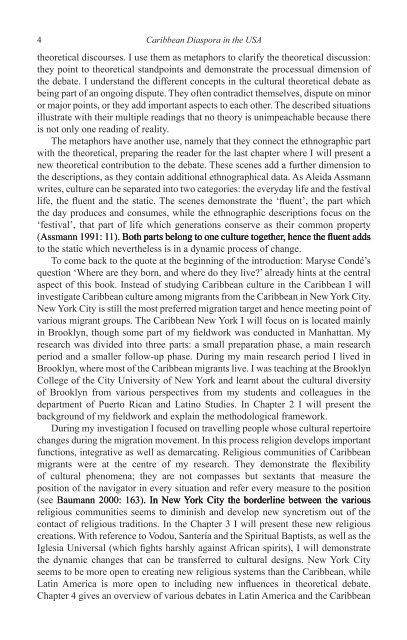Create successful ePaper yourself
Turn your PDF publications into a flip-book with our unique Google optimized e-Paper software.
4<br />
<strong>Caribbean</strong> <strong>Diaspora</strong> <strong>in</strong> <strong>the</strong> <strong>USA</strong><br />
<strong>the</strong>oretical discourses. I use <strong>the</strong>m as metaphors to clarify <strong>the</strong> <strong>the</strong>oretical discussion:<br />
<strong>the</strong>y po<strong>in</strong>t to <strong>the</strong>oretical standpo<strong>in</strong>ts and demonstrate <strong>the</strong> processual dimension <strong>of</strong><br />
<strong>the</strong> debate. I understand <strong>the</strong> different concepts <strong>in</strong> <strong>the</strong> cultural <strong>the</strong>oretical debate as<br />
be<strong>in</strong>g part <strong>of</strong> an ongo<strong>in</strong>g dispute. They <strong>of</strong>ten contradict <strong>the</strong>mselves, dispute on m<strong>in</strong>or<br />
or major po<strong>in</strong>ts, or <strong>the</strong>y add important aspects to each o<strong>the</strong>r. The described situations<br />
illustrate with <strong>the</strong>ir multiple read<strong>in</strong>gs that no <strong>the</strong>ory is unimpeachable because <strong>the</strong>re<br />
is not only one read<strong>in</strong>g <strong>of</strong> reality.<br />
The metaphors have ano<strong>the</strong>r use, namely that <strong>the</strong>y connect <strong>the</strong> ethnographic part<br />
with <strong>the</strong> <strong>the</strong>oretical, prepar<strong>in</strong>g <strong>the</strong> reader for <strong>the</strong> last chapter where I will present a<br />
new <strong>the</strong>oretical contribution to <strong>the</strong> debate. These scenes add a fur<strong>the</strong>r dimension to<br />
<strong>the</strong> descriptions, as <strong>the</strong>y conta<strong>in</strong> additional ethnographical data. As Aleida Assmann<br />
writes, culture can be separated <strong>in</strong>to two categories: <strong>the</strong> everyday life and <strong>the</strong> festival<br />
life, <strong>the</strong> fluent and <strong>the</strong> static. The scenes demonstrate <strong>the</strong> ‘fluent’, <strong>the</strong> part which<br />
<strong>the</strong> day produces and consumes, while <strong>the</strong> ethnographic descriptions focus on <strong>the</strong><br />
‘festival’, that part <strong>of</strong> life which generations conserve as <strong>the</strong>ir common property<br />
(Assmann 1991: 11). Both parts belong to one culture toge<strong>the</strong>r, hence <strong>the</strong> fluent adds<br />
to <strong>the</strong> static which never<strong>the</strong>less is <strong>in</strong> a dynamic process <strong>of</strong> change.<br />
To come back to <strong>the</strong> quote at <strong>the</strong> beg<strong>in</strong>n<strong>in</strong>g <strong>of</strong> <strong>the</strong> <strong>in</strong>troduction: Maryse Condé’s<br />
question ‘Where are <strong>the</strong>y born, and where do <strong>the</strong>y live?’ already h<strong>in</strong>ts at <strong>the</strong> central<br />
aspect <strong>of</strong> this book. Instead <strong>of</strong> study<strong>in</strong>g <strong>Caribbean</strong> culture <strong>in</strong> <strong>the</strong> <strong>Caribbean</strong> I will<br />
<strong>in</strong>vestigate <strong>Caribbean</strong> culture among migrants from <strong>the</strong> <strong>Caribbean</strong> <strong>in</strong> <strong>New</strong> <strong>York</strong> <strong>City</strong>.<br />
<strong>New</strong> <strong>York</strong> <strong>City</strong> is still <strong>the</strong> most preferred migration target and hence meet<strong>in</strong>g po<strong>in</strong>t <strong>of</strong><br />
various migrant groups. The <strong>Caribbean</strong> <strong>New</strong> <strong>York</strong> I will focus on is located ma<strong>in</strong>ly<br />
<strong>in</strong> Brooklyn, though some part <strong>of</strong> my fieldwork was conducted <strong>in</strong> Manhattan. My<br />
research was divided <strong>in</strong>to three parts: a small preparation phase, a ma<strong>in</strong> research<br />
period and a smaller follow-up phase. Dur<strong>in</strong>g my ma<strong>in</strong> research period I lived <strong>in</strong><br />
Brooklyn, where most <strong>of</strong> <strong>the</strong> <strong>Caribbean</strong> migrants live. I was teach<strong>in</strong>g at <strong>the</strong> Brooklyn<br />
College <strong>of</strong> <strong>the</strong> <strong>City</strong> University <strong>of</strong> <strong>New</strong> <strong>York</strong> and learnt about <strong>the</strong> cultural diversity<br />
<strong>of</strong> Brooklyn from various perspectives from my students and colleagues <strong>in</strong> <strong>the</strong><br />
department <strong>of</strong> Puerto Rican and Lat<strong>in</strong>o Studies. In Chapter 2 I will present <strong>the</strong><br />
background <strong>of</strong> my fieldwork and expla<strong>in</strong> <strong>the</strong> methodological framework.<br />
Dur<strong>in</strong>g my <strong>in</strong>vestigation I focused on travell<strong>in</strong>g people whose cultural repertoire<br />
changes dur<strong>in</strong>g <strong>the</strong> migration movement. In this process religion develops important<br />
functions, <strong>in</strong>tegrative as well as demarcat<strong>in</strong>g. Religious communities <strong>of</strong> <strong>Caribbean</strong><br />
migrants were at <strong>the</strong> centre <strong>of</strong> my research. They demonstrate <strong>the</strong> flexibility<br />
<strong>of</strong> cultural phenomena; <strong>the</strong>y are not compasses but sextants that measure <strong>the</strong><br />
position <strong>of</strong> <strong>the</strong> navigator <strong>in</strong> every situation and refer every measure to <strong>the</strong> position<br />
(see Baumann 2000: 163). In <strong>New</strong> <strong>York</strong> <strong>City</strong> <strong>the</strong> borderl<strong>in</strong>e between <strong>the</strong> various<br />
religious communities seems to dim<strong>in</strong>ish and develop new syncretism out <strong>of</strong> <strong>the</strong><br />
contact <strong>of</strong> religious traditions. In <strong>the</strong> Chapter 3 I will present <strong>the</strong>se new religious<br />
creations. With reference to Vodou, Santería and <strong>the</strong> Spiritual Baptists, as well as <strong>the</strong><br />
Iglesia Universal (which fights harshly aga<strong>in</strong>st African spirits), I will demonstrate<br />
<strong>the</strong> dynamic changes that can be transferred to cultural designs. <strong>New</strong> <strong>York</strong> <strong>City</strong><br />
seems to be more open to creat<strong>in</strong>g new religious systems than <strong>the</strong> <strong>Caribbean</strong>, while<br />
Lat<strong>in</strong> America is more open to <strong>in</strong>clud<strong>in</strong>g new <strong>in</strong>fluences <strong>in</strong> <strong>the</strong>oretical debate.<br />
Chapter 4 gives an overview <strong>of</strong> various debates <strong>in</strong> Lat<strong>in</strong> America and <strong>the</strong> <strong>Caribbean</strong>


















